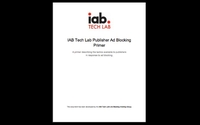The Art Of The DEAL: IAB Proposes Explicit Value Exchange To Thwart Blocking
- by Joe Mandese @mp_joemandese, March 7, 2016
 Five months after the Interactive Advertising Bureau (IAB) proposed a kinder, gentler, LEANer solution to ad blocking, the digital ad trade bureau is proposing that publishers take a more
aggressive gatekeeping role for dealing with consumers who use ad blockers. The new stance, which is outlined in a white paper released this morning by the IAB Tech Lab, advocates yet another acronym
-- this one called DEAL -- for Detect, Explain, Ask and Lift of Limit (depending on the consumer’s action).
Five months after the Interactive Advertising Bureau (IAB) proposed a kinder, gentler, LEANer solution to ad blocking, the digital ad trade bureau is proposing that publishers take a more
aggressive gatekeeping role for dealing with consumers who use ad blockers. The new stance, which is outlined in a white paper released this morning by the IAB Tech Lab, advocates yet another acronym
-- this one called DEAL -- for Detect, Explain, Ask and Lift of Limit (depending on the consumer’s action).
The IAB Tech Lab also released an ad-blocking detection script available to all IAB and IAB Tech Lab members around the world.
The white paper, which the IAB calls a “primer” for publishers who want to proactively combat ad blocking, can be downloaded here. But the net effect proposes that publishers engage in a proactive value exchange with consumers who land on their pages with ad blocking software.
Once ad blockers are detected, the IAB recommends a series of actions beginning with an education process that explains the “value exchange” digital ads enables (that is, free or subsidized access to the publisher’s content), and then recommends asking consumers to “change their behavior” in order to keep things “equitable.”
Depending on the consumer’s response, the IAB recommends that publishers then either “lift” technology walls blocking access to their content, or use them to “limit” access to it.
Several big publishers have already begun to adopt that protocol, including Forbes, which uses open-source ad-blocking detection scripts to trigger a response asking users to turn off their ad-blocking software in order to access its content.
“The release of this primer in conjunction with the open-source ad blocking detection script will open the door for transparency and meaningful dialogue with visitors using ad blockers,” IAB Tech Lab General Manager Scott Cunningham said in a statement announcing the new approach, adding that the tactic will enable publishers “the chance to cut through the blockade, ensuring the strength of the open, ad-supported Internet.”
DEAL is a much more aggressive approach than the so-called LEAN response the IAB initially recommended last October in response to the growing popularity of new iterations of ad blocking software.
LEAN, which some in the industry saw as a relatively tepid response, stands for Light, Encrypted, Ad Choice-Supported and Non-Invasive ads, which seemed to put much of the onus on advertisers and agencies to create advertising that consumers wouldn’t want to block.
DEAL takes a more aggressive position, recognizing that ad blockers are a new fact of life for publishers and consumers alike and require a new form of value exchange.


How is this going to work unless unless publishers with "good" content, who get users to disable their ad blockers, also find ways to minimize the disruptive impact of too many ads per page and their helter-skelter intrusions on the user's experience with the site?
Here, here on having publishers control and regulate ads to the benefit of the users. I remember a time when Yahoo and other big publishers had set creative size restrictions to insure fast page loads. Time to start restricting the demand on performance and quality again.